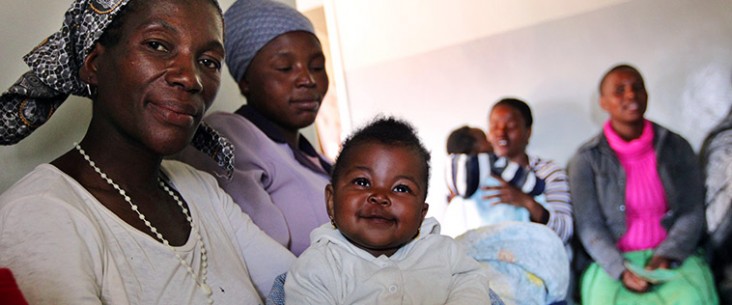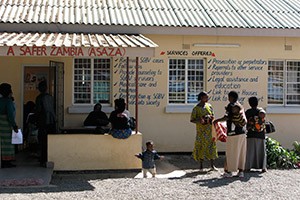- What We Do
- Agriculture and Food Security
- Democracy, Human Rights and Governance
- Economic Growth and Trade
- Education
- Environment and Global Climate Change
- Gender Equality and Women's Empowerment
- Global Health
- Humanitarian Assistance
- Transformation at USAID
- Water and Sanitation
- Working in Crises and Conflict
- U.S. Global Development Lab
Speeches Shim

Gender Norms and Inequalities: Their Impact on HIV and AIDS
Gender norms and inequalities increase women's and girls' vulnerability to HIV due to multiple factors. Often women and girls have a limited ability to negotiate safer sex and are unable to test for HIV, disclose their status, and access HIV treatment because of fear of violence and abandonment. Gender norms and inequalities also affect men and boys, heightening their risk of acquiring HIV and transmitting the infection to others. Such norms can encourage men and boys to adopt risk-taking behavior, discourage accessing health care, and narrowly define men's and boys' roles as partners.
People who are perceived to go against gender norms around masculinity and sexuality, such as men who have sex with men (MSM), transgender populations and others, face inequalities that place them at greater risk of not only HIV infection but also gender-based violence (GBV).
GBV and HIV create a vicious cycle. GBV fosters the spread of HIV by limiting a person's ability to negotiate safe sexual practices, disclose HIV status, and access services due to fear of reprisal. Sexual violence can lead directly to HIV infection. Disclosure of HIV status can also incite sexual violence and other forms of GBV.
Harmful gender norms and disparities are the result of biological, structural, socio-economic, and cultural conditions, as well as stigma and discrimination – all of which impede individuals' access to resources that can prevent and mitigate HIV.

USAID's Response
Addressing gender norms, preventing and responding to GBV, transforming power dynamics, and promoting gender equality are essential to ending the HIV epidemic. As a key implementer of the U.S. President's Emergency Plan for AIDS Relief (PEPFAR), the U.S. Agency for International Development (USAID) works to integrate gender into all of its HIV/AIDS programming.
USAID strives to ensure that all people – women, men, girls, boys, and lesbian, gay, bisexual, transgender, and intersex (LGBTI) individuals:
- Are able to access and utilize HIV prevention, care and treatment services
- Protect themselves and practice healthy behaviors
- Exercise their rights
- Live lives free from violence, stigma and discrimination
USAID's work is guided by key U.S. Government documents, including the USAID Gender Equality and Female Empowerment Policy [PDF, 2.8MB], the USAID LGBT Vision for Action [PDF, 1.3MB], the PEPFAR Gender Strategy [PDF, 1.5MB] and the U.S. Strategy to Prevent and Respond to GBV Globally [PDF, 1.8MB].
USAID advances:
- The strategic use of data
- Efforts to engage boys and men in HIV prevention, care and treatment and in GBV prevention/response
- A focus on adolescent girls and young women as a priority population
- Attention to the specific needs and vulnerabilities of gender and sexual minorities and members of other key populations
- The integration of HIV and GBV prevention/response initiatives
- Gender-equitable policies and laws
- Gender-equitable access to income and productive resources
Programmatic Highlights
DREAMS
The DREAMS (Determined, Resilient, Empowered, AIDS-free, Mentored and Safe) Initiative builds upon USAID's decades of experience in empowering young women and advancing gender equality across the sectors of global health, education and economic growth. USAID partners with community, faith-based, and non-governmental organizations whose credibility within communities and capacity to mobilize significant numbers of volunteers allow USAID to address the structural inequalities impacting girls' vulnerability to HIV.
PEPFAR Gender-based Violence Initiative
From 2011 to 2014, PEPFAR implemented the interagency Gender-based Violence Initiative (GBVI), a three-year program in the Democratic Republic of the Congo [PDF, 593KB], Mozambique [PDF, 1.3MB] and Tanzania [PDF, 1.3MB]. GBVI's aim was to demonstrate that GBV prevention and response activities could be integrated into HIV platforms and to understand the best approaches for achieving a successful integrated response through existing HIV prevention, care, and treatment services at both clinical and community facilities. Over three years, GBVI interventions and services reached more than 1.3 million individuals across all three countries. Clinic- and community-level services included GBV screening, post-GBV care, HIV post-exposure prophylaxis, and HIV/GBV prevention programs that aimed to promote gender-equitable norms in communities.
Additional Resources
U.S. Government Strategies, Guides and Policies
- USAID Gender Equality and Female Empowerment Policy [PDF, 2.8MB]
- USAID LGBT Vision for Action [PDF, 1.3MB]
- PEPFAR Gender Strategy [PDF, 1.5MB]
- U.S. Strategy to Prevent and Respond to GBV Globally [PDF, 1.8MB]
Gender-based Violence
- Package of Services for Post-violence Care
- Infographic - Violence and HIV [PDF, 517KB]
- Promoting Gender Equality in HIV and AIDS
- Program Guide for Integrating GBV Prevention and Response into Programming [PDF, 771KB]
- Responding to Intimate Partner Violence and Sexual Violence Against Women: WHO Clinical and Policy Guidelines [PDF, 1.1MB]
- Technical Considerations for the Clinical Management of Children and Adolescents Who Have Experienced Sexual Violence [PDF, 4.0MB]
- Strengthening Linkages between Clinical and Social Services for Children and Adolescents Who Have Experienced Sexual Violence: A Companion Guide [PDF, 3.1MB]
- USAID participates in 16 Days of Activism against Gender-based Violence
Adolescent Girls and Young Women
- Scaling up Evidence Informed HIV Prevention for Adolescent Girls [PDF, 1.5MB]
- Gender Considerations along the HIV Treatment Cascade: An Evidence Review with Priority Actions [PDF, 1.8MB]
Key Populations, Gender and Sexual Diversity
- Gender and Sexual Diversity Training: A Facilitator's Guide for Public Health and HIV Programs [PDF, 3.2MB]

Comment
Make a general inquiry or suggest an improvement.